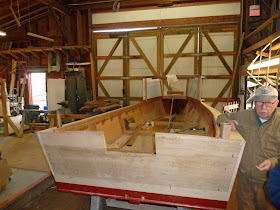At the mouth of the Patuxent River, which leads to Solomon’s Island, Drum Point protrudes into the river. To mark the entrance to the river and to keep mariner’s off the shoal, a lighthouse was built on the point. It is referred to as a screw-pile lighthouse because the steel pilings supporting the lighthouse were screwed into the bay bottom. The history of the lighthouse has been preserved by the Calvert Museum by moving the lighthouse to the museum property.
The lighthouse was built with living quarters for the lighthouse keeper and his family. Since the light was originally powered by kerosene, the lighthouse keeper had to be present at all times to keep the light burning. The small house was divided into a number of living spaces.
The rooms are quite small, but were unbelievably tiny considering the long-term lighthouse keeper and his wife had 10 kids living at the lighthouse.
The light was amplified by a Fresnel lens. The light was transmitted in two colors, white and red, to give the mariner the direction he was in relation to the light. The different colors were created by sheets of red glass mounted inside the lighthouse windows.

When the fog was too thick for the light to penetrate, a hand-cranked mechanism would throw a spring-loaded hammer through the wall into a bell, to warn mariners by sound.
Boats of all varieties were on display. Below are two dug-out canoes, an early version, and a later, more artistic version. The large boat is a Buy Boat, where crabbers or oystermen would take their catch to sell, then the Buy Boat would take the consolidated catches to a processing plant on shore.
The buildings housed full-size boats and many models, from small crabbing skiffs to large passenger steamships.
Numerous old engines that powered boats had been restored and were on display, always a favorite for Glen.
The history of sea life of the Chesapeake was on display. A prehistoric shark skeleton had been reconstructed at actual size.
Our tour of the museum was not completed and the time was approaching for the museum to close. As a man walked toward us, we expected to get an announcement that it was time to leave – instead, he asked: “Would you like a behind the scenes tour?” Of course, we took advantage of his offer and gained a greater insight into the museum's displays. Douglass Alves has been the director of the museum for decades and had a wealth of knowledge to share. He provided additional information on the current threats to the Chesapeake from pollution, misuse, and invasive species of plant and animal life. Jill particularly enjoyed visiting with the Otters, which are only on display for short periods as their active times do not coincide with museum hours.
Chesapeake Bay Maritime Museum, St. Michaels
A different feature of the Chesapeake Bay Maritime Museum is the focus on wooden boat building and restoration. A combination of full-time staff and volunteers rebuild old boats so they may continue to display the work and pleasure boats that plied the waters of the Bay. Mister Jim is a Chesapeake Buy Boat that is undergoing restoration.
The museum also continues the skills of wooden boat building, using the process and tools of the times to build replicas of historical boats. These boats are not for display; they are intended to be used as working or pleasure boats. There was a crabbing skiff approaching the final stages of construction and a smaller crabbing skiff that was just finished. Since they are working boats, reliability and dependability are issues, so modern engines are employed.
Long-term volunteers get the opportunity to build boats that they will own when completed. One of the volunteers was in the final stages of building a wooden canoe, which weighed less than 15 pounds.
Racing has always been a part of boating and was on display in St. Michaels.
Tangier Island
There is living history on Tangier Island, actually a group of small islands in the middle of the Chesapeake Bay, just below the Virginia/Maryland border. The Island was settled by English immigrants who have made their living from crabbing. Isolation on the island has preserved many of their ancestral ways, including an Old English dialect. The only marina on the Island is Park’s Marina, owned and operated by Mr. Parks. Everyone calls him “Mr. Parks” and he calls all men “Clarence.” Mr. Parks was a crabber for over 65 years and a stay at the marina includes a guided tour of the entire island on his gas-powered golf cart. The highest point on Tangier Island is 4 feet above sea level. The island is sinking and the water levels are rising, so the life of the Island is threatened. An island farther north, Holland Island, once had farms, hotels, businesses. As the island began disappearing into the Bay, one homeowner held on for the hope that he would be able to maintain his home on the Island. In 2010, the Bay finally claimed the last building, his home.
Photographic images of Tangier Island, Mr. Parks, and the Tangier Island Museum would be most appropriate here, but the digital images somehow disappeared. Technology can be our friend or our most frustrating experience. To share some of the current concerns of Tangier Island, a link to a YouTube video is below. Thanks to Bob and Kemba DeGroot for locating this link.

























No comments:
Post a Comment